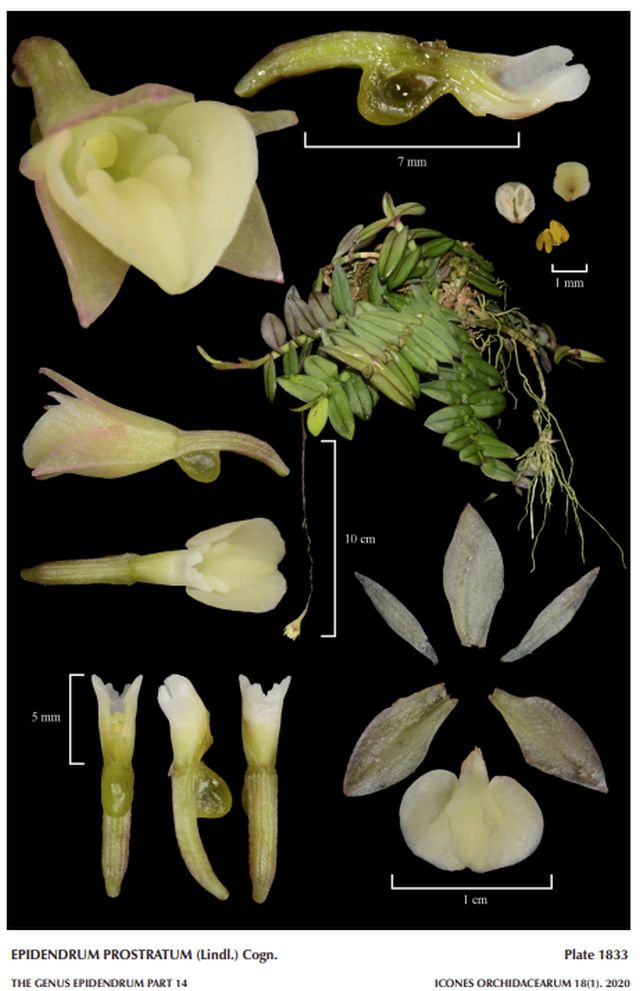

Epidendrum prostratum (Lindl.) Cogn. 1898 GROUP Physinga
LCDP Photo by © R Jimenez & A. Cisneros and Icones Orchidacearum 18(1) plate 1833 2020
Photo by © Alexander Damien P. and his Flickr Orchid Photo Website





Common Name The Prostrate Epidendrum
Flower Size .4" [1 cm]
Found in Guyana, Venezuela, Colombia, Ecuador, Peru and Bolivia in lower, wet montane forests at elevations around 100 to 810 meters as a mini-miniature to small sized [=including the inflorescence], hot to warm growing, caulescent, prostrate to pendent growing epiphyte with a short, simple, cane-like, terete at base, slightly laterally compressed towards the apex, straight stem enveloped completely by imbricate, distichous, foliaceous sheaths carrying 9 to 15, all along the stem, alternate, distichous, spreading, twisted so as to be on the same plane as the stem, lanceolate, apex acute, margin entire, fleshy, adaxial surface green, abaxial surface green tinged purple leaves that blooms in the fall and winter on a terminal, without a spathe, elongate, compressed, fractiflex, provided with 4 to 5 approximate, conduplicate, elongate, scarious bracts, 2 to 8" [5 to 20 cm] long, successively single, 1 to 10 flowered inflorescence with minute, ovate-lanceolate, acute, amplexicaul, shorter than the ovary floral bracts and carrying subcampanulate, trumpet shaped flowers.
"Epidendrum prostratum belongs to the GROUP Physinga which is characterized by the generally small, caespitose plants, the inflorescence apical and racemose producing new racemes with time and thus pluri-racemose, the successive flowers opening one at a time on an elongate peduncle with acuminate bracts, and the lip entire and the ovary with a prominent vesicle. The species is recognized by the short stem with numerous fleshy leaves, spreading, lying on the same plane as the stem, lanceolate, apex acute, the flowers trumpet-shaped, green to pale rose-purple, lip white, the lip transversely reniform, 3- ribbed, sepals 7.0-9.7 mm long and the clinandrium-hood very prominent and deeply emarginate. Epidendrum macroclinium is vegetatively very similar but is recognized by the .6 to 1.8" [1.5 to 4.5 cm] long, spreading, ovate-lanceolate, gray-green leaves, sometimes with the foliar veins thickened and very evident on the basal half of the upper side of the leaves, but smaller flowers; sepals .2 to .28" [5 to 7 mm] long, petals linear lanceolate, clinandrium-hood very large, entire, funnel-shaped, apical margin dentate, and the lip bilobed with a single mid-rib. Epidendrum physodes Rchb.f. has sepals 7 mm long, column longer 3.5-4 mm long, is truncate lacking a prominent clinandrium-hood, the lip entire, transversely ovate, apex entire. Epidendrum polygonatum Lindl. has a zig-zag inflorescence, and a sub-reniform lip, apically emarginate, disc tricallose, 5-ribbed. Epidendrum acreense (Brieger & Bicalho) Christenson has sepals .2 to .24" [5 to 6 mm] long, and the lip transversely oblong, apex slightly emarginate, with two prominent, long call." Hagsater etal 2020
Synonyms *Physinga prostrata Lindl. 1838
References W3 Tropicos, Kew Monocot list , IPNI ; Repert. Sp. Nov. Regni. Veg. Beih. 19: 43. Costa Rica Schlechter 1923; Orchids of Peru Vol 2 Fieldiana Schweinfurth 1959; Die Orchideen 3 Auflage Bd 1 Sonderabdruck aus Schlechter Lieferung 9 513 - 576 Brieger, Maatsch and Senghas 1977 as Physinga prostrata; Rudolf Schlechter Die Orchideen Lieferung 42/3 2001 as Physinga prostrata photo fide; Icones Plantarum Tropicarum Plate 482 Dodson 1989 drawing fide; Native Colombian Orchids Vol 5 COS 1994 photo fide; Icones Orchidacearum Peruviarum Plate 054 Bennett & Christenson 1998 drawing fide; Native Ecuadorian Orchids vol 2 Dodson 2001 drawing fide; Rudolf Schlechter Die Orchideen Band 1C lieferung 42 - 43 pg 2626 - 2762 Brieger 2001 as Physinga prostrata photo fide; Flora of the Venezuelan Guayana Vol 7 Steyermark, Berry, Yatskievych and Holst 2003; Orchids of Bolivia Vol II Laelinae Vasquez & Ibisch 2004 photo fide; Orquideas de la Serrania del Baudo Choco Colombia Misas 2005 drawing/photo not = E macroclinium; Icones Orchidacearum 11 Plate 1159 Hagsater 2008 see recognition section; Icones Orchidacearum 11 Plate 1184 Hagsater 2008 see recognition section; Orchid Digest Vol 73 #3 2009; Icones Orchidacearum 13 Plate 1325 Hagsater & Santiago 2010 See recognition section; Icones Orchidacearum 13 Plate 1353 Hagsater & Dodson 2010 See Recognition section; Orquideas, Tesoro de Colombia Vol 2 Ortiz & Uribe 2017 photo fide; Icones Orchidacearum 18(1) plate 1833 Hagsater & Santiago 2020 photos fide; Icones Orchidacearum 18(2) Plate 1873 Hagsater & Jimenez 2021 see recognition section
--------------------------------------------------------------------------------------------------------------------------